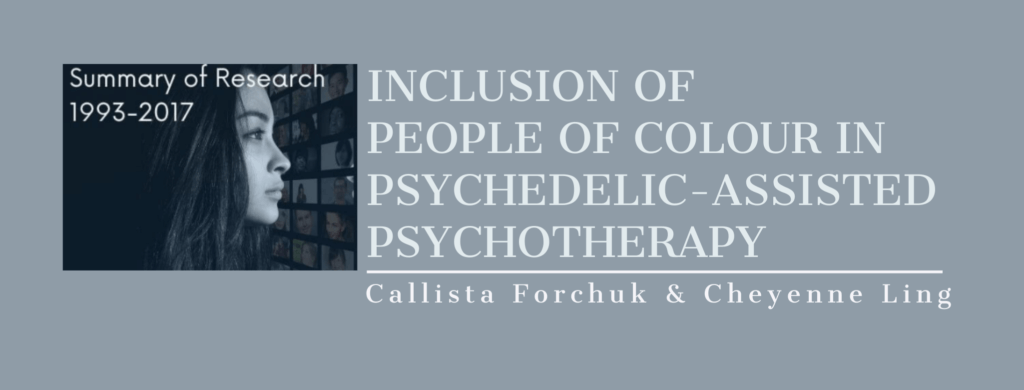Are people of colour included in psychedelic research?
In their paper “Inclusion of people of color in psychedelic-assisted psychotherapy: a review of the literature” Michaels et al. (2018) reviewed studies on psychedelic-assisted psychotherapy published between 1993 and 2017 across countries to examine rates of inclusion for people of colour. Below we have summarized the key takeaways from this paper.
History of psychedelic medicine
Psychedelic medicine has roots in Indigenous communities, who used the substances in sacred and healing rituals (Sessa, 2016). In the Western world, psychedelic medicine has been explored through two distinct waves. Psychedelics were not yet illegal during the first wave (1950-1985), allowing researchers freedom to study the substances. However, research was halted and the substances made illegal following ethical and scientific violations, use in the wider community, and safety concerns. The second wave (late 1990s – present) was spurred by the availability of non-government funding from the Multidisciplinary Association of Psychedelic Studies (MAPS) and a lack of effective psychiatric treatments. Learning from previous mistakes, conscious efforts are being made in this wave to focus on ethical, rigorous, and safe research.
Psychedelic research is White dominant
Although psychedelic substances show promise for a range of mental illnesses, research has been generally limited to small samples of mostly White participants. Findings may not apply to people of colour, or psychological concerns specific to non-White groups (e.g., race-based trauma).
Psychological disorders across people of colour
Evidence suggests that rates of psychological disorders occur in people of colour at equivalent or higher rates to non-Hispanic Whites. However, the diagnoses of mental disorders are often missed in clinical interviews for people of colour, presenting barriers to participation in treatment and clinical research.
Symptoms and causes of mental illnesses may differ depending on racial-cultural backgrounds in ways that are not well-understood. Low rates of mental health service use among people of colour, resulting from social and cost barriers, and a history of unethical treatment of minorities in medical research (Katz et al., 2006), may contribute to this lack of understanding. Not only do people of colour display distinct symptom presentations, but mental illnesses may be caused by experiences such as race-based discrimination, including microaggressions (i.e., forms of everyday discrimination communicating hostility or negative expectations). Evidence also suggests that ethnic groups vary in their reactions to traumatic events, and that ethnic identity may be associated with psychological disorders. The importance of considering racial-cultural issues in mental health is thus imperative in establishing effective treatments and research.
Methods
“Psychedelics” were defined in this review as compounds primarily acting through the neurotransmitter serotonin (i.e., LSD, DMT/ayahuasca, ibogaine, MDMA and psilocybin). Studies were included if they involved the use of a psychedelic substance in the treatment of a psychological disorder. Studies conducted before 1993 were excluded, as the “National Institute of Health (NIH) Revitalization Act of 1993” was passed this year, which mandated for the inclusion of women and minority groups in all NIH-funded studies (unless there was a clear scientific basis for exclusion).
Results
The final compilation included 16 studies conducted from 2008 to 2017 with a total of 282 participants (all 18 years or older). The results revealed 82.3% of the participants identified as non-Hispanic White leaving only 18.4% of participants who identified as people of colour such as African American, Latino origin, Asian origin, Indigenous origin, mixed origin and others. The average percentage of people of colour in the countries of origin across all 16 studies was 38.2%. Thus, the representation of people of colour in this review (18.4%) was lower than their average national representation.
Discussion
Michaels et al. (2018) described potential explanations for the low rates of inclusion of people of colour.
| Reasons for lack of inclusion | Suggestions to improve |
| A lack of cultural inclusivity in the research community. Participants only qualify for study inclusion if they have a diagnosable mental disorder but the Diagnostic and Statistical Manual of Mental Disorders, 5th Edition (DSM-5), does not properly address cultural variations in psychopathology. | Add cultural variations in psychopathology to the DSM-5, including race-based trauma which can be experienced by people of colour and includes symptoms similar to PTSD (Helms, Nicolas & Green, 2010). Without culturally inclusive diagnostic criteria, minorities may not qualify for treatments or clinical research. |
| Ineffective recruitment methods. Primarily relying on mental health clinicians for participant referrals excludes people of colour by default. Many providers do not accurately identify mental illnesses in minorities due to distinct symptom presentation between cultures. | Recruit equally from physicians, alternate care providers, or providers who offer affordable health care. Some minorities may not be able to afford specialized mental health treatment. |
| The absence of ethnic diversity in psychedelic researchers. The field of psychedelic research has predominantly been White men with few people of colour. | Including culturally diverse researchers may allow for a better understanding of how to address race-based trauma and has been shown to improve the treatment process. |
| Low involvement of minorities in psychedelic studies may be due to a deeply embedded aversion and resistance to the field. People of colour may feel extra fearful when administered a drug in research because of historical and current injustices related to drug-related offenses. | Create a culturally inclusive, stigma free research environment. Address any stereotypes that people of color may feel when participating in psychedelic research studies. |
Conclusion
Michaels et al. (2018) found that people of colour are immensely under represented in psychedelic research. Without diversifying this area of research, it will be unclear if psychedelic psychotherapy can be used to beneficially treat issues such as race-based trauma and other culturally unique challenges.
Written by Callista Forchuk and Cheyenne Ling
References
Helms, J. E., Nicolas, G., & Green, C. E. (2010). Racism and ethnoviolence as trauma: Enhancing professional training. Traumatology, 16(4), 53–62. https://doi.org/10.1177/1534765610389595
Katz, R. V., Russell, S. L., Kegeles, S. S., Kressin, N. R., Green, B. L., Wang, M. Q., … & Claudio, C. (2006). The Tuskegee Legacy Project: willingness of minorities to participate in biomedical research. Journal of health care for the poor and underserved, 17(4), 698.
Michaels, T.I., Purdon, J., Collins, A. et al. Inclusion of people of color in psychedelic-assisted psychotherapy: a review of the literature. BMC Psychiatry 18, 245 (2018). https://doi.org/10.1186/s12888-018-1824-6
Sessa, B. (2016). The history of psychedelics in medicine. Handbuch Psychoaktive Substanzen. Springer Reference Psychologie. Berlin: Springer.


Great summary of the findings, reasons for lack of inclusion and suggestions to improve. No one can deny the under-representation of people of colour in psychedelic studies (as participants and/or primary investigators) – and I am glad this is being brought to light and being addressed in this context. I do wonder though, if perhaps this not just a problem in psychedelic studies – search any literature databases and pull a random article and you will find that people of colour are under-represented in most research. Many authors do include a statement on the limitations of their study, like ‘there is a lack of representation of specific groups in our sample’ which ‘impacts the generalization of the findings’ – I’m just not sure how much of an impact those statements have for future research. Regardless, great job outlining this issue in psychedelic studies.